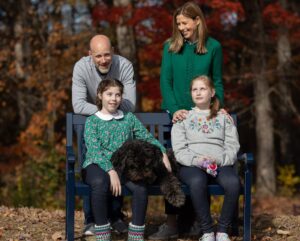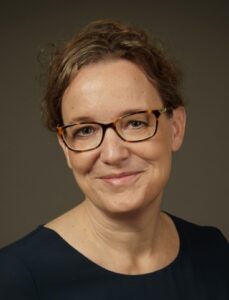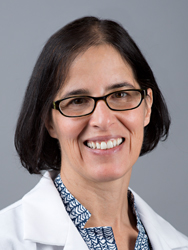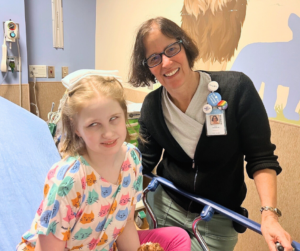In May 2022, Yael Shiloh-Malawsky, MD, a neurologist at the UNC School of Medicine, met two new patients battling a rare and fatal neurological disease called Batten disease. With UNC’s help, the twin girls can get personalized treatment from bench to bedside in record time.
When Karen and David Kahn’s daughters, Amelia and Makenzie, were born in 2010, they knew that life with twins would be different. But after just 18 months, the Kahn family was forced into an unexpected and tragic situation.
Amelia started slurring her words and actions. At the age of two, he was diagnosed with autism. Then, at the age of 7, both girls started having unexplained visions and were declared legally blind.
Desperate to find a diagnosis, the Kahns went to a geneticist for testing, eventually learning that both girls had a rare and progressive genetic disorder. front of the nervous system called childhood Batten syndrome, or CLN3, which has no cure.
They refused to give up on the disease and worked to find a cure, and now – seven years after the diagnosis – the family is part of the first study of the hospital at UNC Health, which Yael Shiloh-Malawsky, MD, is in charge of. professor of neurology.
A new, personalized treatment for Two
Batten syndrome is a rare neurodegenerative condition that affects about 1 in every 100,000 births. Around the age of six or seven, patients often begin to experience vision loss, followed by paralysis, cognitive decline, seizures, and speechlessness. Because the condition causes rapid brain death, life expectancy ranges from teens to early twenties.

This disease is associated with genetic changes in genes called genes CLN3. Located on chromosome 16, the CLN3 Proteins, encoded by genes, are essential for directing the body to store and break down cellular waste in cellular compartments called lysosomes. When this waste builds up in the body’s cells, it causes cell death in the brain and eyes.
The Kahn girls had another genetic test. Geneticists have confirmed that Amelia and Makenzie have a genetic mutation common to CLN3 Batten disease.
But geneticists also found something else. The girls have another genetic makeup and CLN3 genetics – never seen before in someone with Batten disease.
Shortly after his diagnosis, the Kahns founded the ForeBatten Foundation, a non-profit organization that supports research and support for children with Batten disease for the families of those affected by the disease. It was at this point that the Kahn family reached out to Michelle L. Hastings, PhD, Pfizer Upjohn Research Professor of Pharmacology at the University of Michigan Medical School, to discuss antisense oligonucleotide therapy.
Hastings has been studying RNA molecules called antisense oligonucleotides (ASOs) for more than 20 years. Just like a pair of growing molecular tweezers, short RNA molecules can target specific sites. and genes and correct gene expression to restore protein function.
By January 2021, Hastings is working on a treatment for pediatric patients with the common CLN3 gene and a treatment for Kahn’s female form. This work can be done with the new guidance issued by the US Food and Drug Administration (FDA), which gave instructions to researchers on how to develop a self-diagnostic ASO for people with chronic genetic diseases and it is life threatening.

This new type of randomized trial, often called an “N-of-1” study, is a type of clinical trial that focuses on one person instead of a large group of people. In the case of Makenzie and Amelia, a specific treatment was developed and tested for two patients, an “N-of-2” study.
Jessica Centa, PhD, a senior postdoctoral researcher at the Hastings lab, took cells from tissue biopsies from the two girls, grew them in culture dishes in the lab and used them to test the ASO system to identify those with strength. bringing back words from the genes of girls. They identified a powerful and effective ASO as their guide for the development of personalized therapies.
When researchers develop an ASO drug that may be effective, it’s time to name it. Inspired by the girl’s favorite animals, zebras and monkeys, a customized treatment named Zebronkysen was created. With guidance from ForeBatten’s development team, personalized medicine was created and bottled for use.
“Drugs and drugs are changing,” said Hastings, who is also the director of the RNA Therapeutics Initiative at the University of Michigan. It’s not just pharmaceutical companies that produce drugs for a large number of patients. It is also where family members, primary care physicians, and leading scientists come together to apply new technologies to treat disease.
“As we see more success in individual treatments using ASO, I think that will increase the adoption, which we hope will lead to more treatments.” given to children with juvenile Batten disease and other rare conditions.”
Quick transition from bench to bedside
In May 2022, the Kahn family moved from Scottsdale, AZ to Chapel Hill, NC to be closer to family. Amelia and Makenzie’s Phoenix neurologist reached out to Dr. Shiloh-Malawsky, an expert in pediatric neurodegenerative diseases at the UNC School of Medicine, to help with their care transition at UNC and to establish a new medical center for girls in North Carolina.
Dr. Shiloh-Malawsky became their new neurologist, forming part of a multidisciplinary team at UNC that helped treat the twins’ many symptoms, which included seizures, paralysis, and anxiety. However, after 2022, the disease continued. Diet and movement became a challenge for the girls, increasing the urgency for treatment.

Fortunately, Hastings’ ASO drug was developed for the altered gene in Amelia and Makenzie’s genome. But before Dr. Shiloh-Malawsky brings the treatment to the hospital, and it will receive approval from UNC’s Institutional Review Board (IRB), the UNC Ethics Review Committee, and the FDA. Typically, this process takes a long time.
“This is not like the approval of other study drugs, in the sense that the treatment is created only for these two patients,” Dr. Shiloh-Malawsky said. “Most importantly, we have to do it quickly if we want to help them before they have no more power.”
In spring 2023, the ForeBatten Foundation established an N-of-2 study development group, with UNC serving as the clinical site of the study, and Dr. Shiloh-Malawsky is the principal investigator. The group was able to independently develop an ASO in a clinical trial protocol, submit for FDA approval of a new investigational drug, and receive the company’s approval from the FDA in a little more than a year. The FDA approved the new investigational drug by the end of May 2024.
“This is the first time this type of N-of-1, or N-of-2, personalized treatment is going on at the UNC system,” Dr. Shiloh-Malawsky said. “This is a unique example of how talent, investment and collaboration with many scientists can come together to bring new and innovative treatments to pediatric patients in need. It’s amazing.”
A new proof of concept
In June 2024, just two weeks after the FDA approved the birth control pill, Amelia and Makenzie received their first dose of Zebronkysen. Their ASO drug is being offered as an “N-of-2” clinical trial, with UNC serving as the study site.

The drug is injected into the cerebrospinal fluid through a spinal tap while the girls are under general anesthesia. The girls are being treated under a study protocol with close monitoring to determine the drug’s tolerability and see if it stops further neurodegeneration.
Dr. Shiloh-Malawsky hopes to restore the work of Amelia and Makenzie. CLN3 Genetics can prevent further decline. If it works, the girls will use the drug for the rest of their lives.
But this new drug development affects more than just the Kahn family. This study can be used as evidence for more personalized treatments to help patients with different conditions. CLN3 genetics, other forms of Batten disease, or other childhood genetic diseases.
“There are other patients who may benefit if a drug is developed that affects Batten’s growth in young children,” Dr. Shiloh-Malawsky said. “This is why I am at UNC, to be in a place with knowledge, methods, and interest in scientific progress and their application in the development of assistance for our patients, providing them hope for healing.”
It’s too early to tell what long-term effects the treatment will have on the girls, but so far, the signs are good.
Karen Kahn, mother of Amelia and Makenzie and founder of the ForeBatten Foundation said, “This is probably not a cure. “I think this is a big step in the right direction. When there is no cure for children, finally having something with promise, is exciting. “
The N-of-2 study team is a collaboration of clinical research organizations, laboratories, and drug development experts, including Vanguard Clinical Inc., Science, Charles River Laboratories, Avecia, Argonaut Manufacturing Servicesand other advisors. UNC researchers for the clinical trial include Zheng (Jane) Fan, MD, Jamie Capal, MD, and Elizabeth Jalazo, MD.
Media Contact: Kendall DanielsCommunications Specialist, UNC Health | UNC School of Medicine
#UNC #Accelerated #System #Twins #Rare #Genetic #Disease #Newsroom